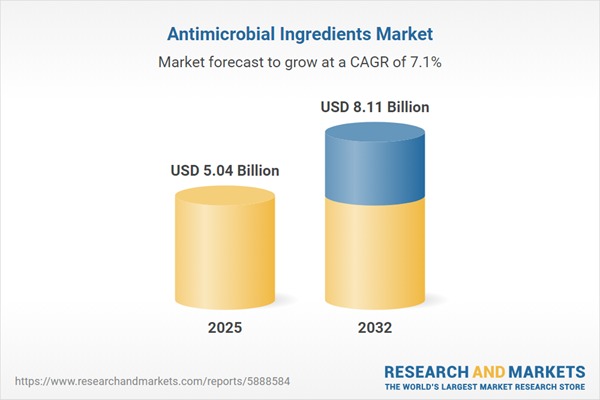Speak directly to the analyst to clarify any post sales queries you may have.
Leaders in the antimicrobial ingredients market face a landscape of evolving regulations, demand for sustainable solutions, and increased scrutiny from end-users. Gaining a competitive edge depends on timely insights, strategic flexibility, and effective risk management.
Market Snapshot: Antimicrobial Ingredients Market Growth & Outlook
The global antimicrobial ingredients market is projected to rise from USD 4.70 billion in 2024 to USD 5.04 billion in 2025, with long-term predictions reaching USD 8.11 billion by 2032. Sectors such as agriculture, healthcare, and food are experiencing surging needs for advanced microbial control products, influenced by stricter regulatory frameworks and shifting consumer preferences. Organizations are responding by investing in bio-based ingredient innovation, streamlining global supply chains, and advancing molecular design approaches to keep pace with new application requirements. Regulatory scrutiny is prompting a focus on agile sourcing and process optimization, essential for maintaining competitiveness in a market shaped by frequent change and heightened compliance standards.
Scope & Segmentation of the Antimicrobial Ingredients Market
- Applications: Agriculture, healthcare, food and beverage production, household cleaning, water treatment, and personal care markets each require tailored microbial management and compliance approaches to address evolving safety standards and consumer expectations.
- Ingredient Types: Bio-based extracts, including essential oils and phenolic compounds, as well as chemical options like silver-based agents and quaternary ammonium compounds, enable businesses to diversify sourcing and foster innovative product development.
- Forms: Foams, gels, liquids, emulsions, granules, and microencapsulated powders offer flexibility for manufacturers in processing, quality control, and distribution, meeting the operational needs of various end-users.
- Functions: Coatings, sanitizers, preservatives, and disinfectants help organizations meet compliance objectives and maintain product quality throughout the supply chain.
- Sources: Microbial fermentation, enzymatic extraction, synthetic chemistry, and petrochemical routes provide adaptable sourcing strategies that impact yield, cost, and sustainability outcomes.
- Geographic Coverage: Americas, Europe, Middle East, Africa, and Asia-Pacific are each characterized by distinctive economic conditions, demand drivers, and regulatory practices. Markets including those in the US, China, Germany, Brazil, South Africa, and India often set new benchmarks for standards and innovation.
- Technology Use: Developments in nanotechnology, encapsulation, and bio-based chemistry improve ingredient stability and shelf life, simplify compliance with environmental regulations, and drive new application opportunities for antimicrobial ingredients.
- Company Developments: Industry leaders such as Lonza Group AG, BASF SE, Dow Inc., Solvay S.A., Evonik Industries AG, LANXESS AG, Clariant AG, Ashland Global Holdings Inc., Arkema S.A., and DuPont de Nemours play a central role in harmonizing regulations and operational processes, shaping competitive standards across the market.
Key Takeaways for Senior Decision-Makers
- Embed sustainable chemistry throughout product and process development to enhance organizational reputation and strengthen supply networks in the antimicrobial ingredients industry.
- Develop agile operational structures that drive ongoing innovation and support timely responses to updated compliance requirements and new areas of demand.
- Conduct comprehensive life-cycle assessments for improved transparency, increased stakeholder confidence, and reduced risks across all business operations.
- Foster collaborations with sector-specific partners and prioritize targeted R&D initiatives, accelerating market introduction of new antimicrobial solutions amid shifting industry demands.
- Diversify supply and procurement models by exploring nearshoring and alternative partnerships, minimizing disruption risk and enhancing readiness in volatile conditions.
- Align sourcing tactics with the specific application requirements of each target sector to facilitate entry into growth markets while optimizing existing channels.
Tariff Impact: Strategic Realignment in the Wake of New U.S. Measures
Changes to U.S. tariff policy are prompting organizations to reinforce domestic and bio-based procurement strategies, broaden their supplier base, and invest in localized production capacities. These adaptations lessen reliance on uncertain raw material markets and cultivate greater procurement efficiency and robust supply chain continuity.
Methodology & Data Sources
This executive summary synthesizes insights from industry specialists and technical experts, in conjunction with a detailed review of relevant patents and scientific literature. International regulatory benchmarks, scenario analyses, SWOT, and PESTEL methodologies contribute to a comprehensive market assessment.
Why This Report Matters for Antimicrobial Ingredients Market Strategy
- Thorough segmentation and practical regional insights help leaders target high-value opportunities and optimize resource allocation.
- Data-backed recommendations support stronger supply chain performance, encourage sustainable innovation, and simplify multi-market regulatory compliance.
- Integrated risk management tools assist in prudent capital deployment and foster trust-based global partnerships.
Conclusion
Senior decision-makers equipped with timely intelligence and adaptable strategies are poised to navigate challenges in the antimicrobial ingredients sector and ensure lasting business resilience.
Additional Product Information:
- Purchase of this report includes 1 year online access with quarterly updates.
- This report can be updated on request. Please contact our Customer Experience team using the Ask a Question widget on our website.
Table of Contents
3. Executive Summary
4. Market Overview
7. Cumulative Impact of Artificial Intelligence 2025
Companies Mentioned
The companies profiled in this Antimicrobial Ingredients market report include:- Lonza Group AG
- BASF SE
- Dow Inc.
- Evonik Industries AG
- Solvay S.A.
- DuPont de Nemours, Inc.
- LANXESS AG
- Clariant AG
- Arkema S.A.
- Ashland Global Holdings Inc.
Table Information
| Report Attribute | Details |
|---|---|
| No. of Pages | 192 |
| Published | October 2025 |
| Forecast Period | 2025 - 2032 |
| Estimated Market Value ( USD | $ 5.04 Billion |
| Forecasted Market Value ( USD | $ 8.11 Billion |
| Compound Annual Growth Rate | 7.0% |
| Regions Covered | Global |
| No. of Companies Mentioned | 11 |









